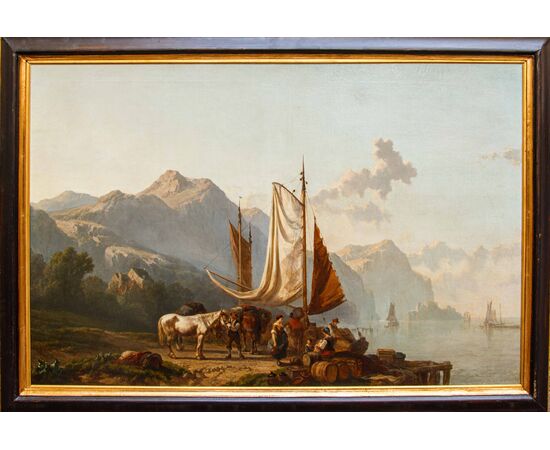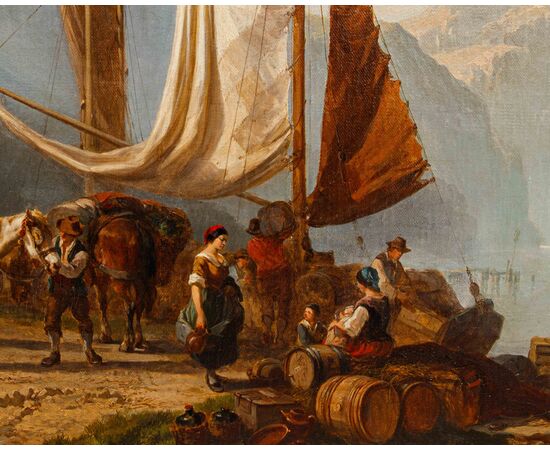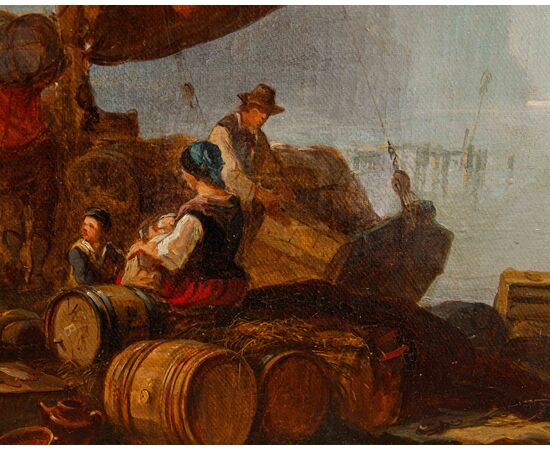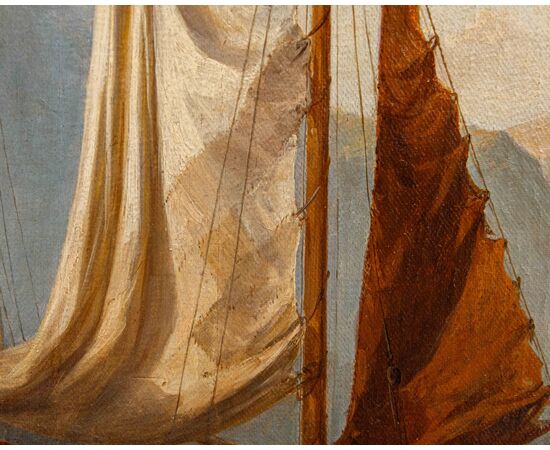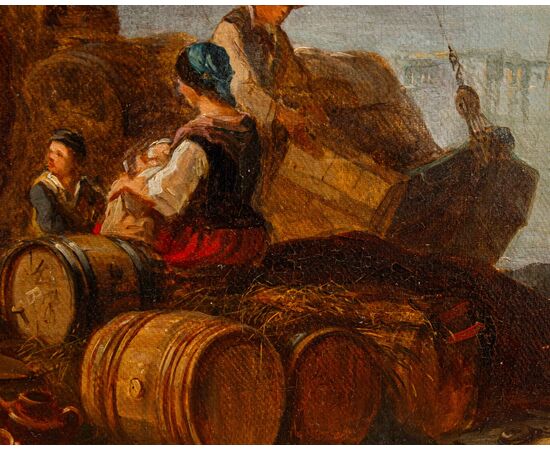Alfred Edouard A. De Bylandt (Brussels 1829 - The Hague 1890), At the landing stage - View of Lake Maggiore
Alfred Edouard A. De Bylandt (Brussels 1829 - The Hague 1890) At the landing stage - View of Lake Maggiore Alfred Edouard A. De Bylandt (Brussels 1829 - The Hague 1890) At the Landing Stage Oil on canvas, 88 x 132.5 cm Framed, 100 x 140 cm Alfred Edouard Agenor de Bylandt (1829-1890) was a fascinating figure in the 19th-century Flemish art scene, whose life and work were distinguished by an interesting fusion of nobility, diplomatic service, and a genuine passion for painting. His biography is interwoven with elements that make him more than just an artist, but a witness and interpreter of his time. Born into an aristocratic family, De Bylandt was not a full-time painter in the traditional sense of the term. His position as chamberlain to the King indicates a role of prestige and responsibility within the Belgian court, a position that undoubtedly placed him in contact with influential circles and allowed him a certain financial freedom to cultivate his artistic inclinations without the pressing commercial demands that often afflicted other painters. This double life, between the halls of royal palaces and the ateliers, between state affairs and canvases, is a distinctive aspect of his personality. His restless spirit and thirst for knowledge manifested themselves through intense travel activity. De Bylandt did not limit himself to painting Belgium or the Netherlands; his canvases are a testament to his numerous stays abroad. In particular, the Swiss and Italian landscapes that adorn his production reveal a particular attention to nature, to the majestic mountains and the luminous atmospheres of the Mediterranean. Italy, with its wealth of history, art, and breathtaking landscapes, was a favorite destination for many artists of the 19th century, and De Bylandt was no exception. His works depicting Italian scenes, such as The Market of Cannollio or Sunset on Lake Maggiore, are not only topographical views, but express a feeling, a personal interpretation of the light and color of those places. His artistic activity took place mainly between Brussels and Holland, with a particular predilection for the Arnhem region, where he probably found inspiration for numerous rural landscapes and scenes of everyday life. This commuting between different geographical and cultural realities undoubtedly enriched his artistic vision, allowing him to range between different subjects and atmospheres. This painting transports us to a picturesque scene on the shores of Lake Maggiore, a place particularly dear to the artist. The work is pervaded by a golden and soft light, typical of sunset or dawn, which envelops the entire landscape giving it a serene and almost idyllic atmosphere. The sky, in the upper part, fades from light and almost yellowish tones to a pale blue, with scattered clouds that stand out softly on the horizon. In the foreground, on the left, the shore of the lake develops, characterized by sparse and rocky vegetation. Some human and animal figures dominate the scene. A white horse or mule, robust and imposing, is at the center of attention, suggesting an activity related to the transport of goods or people. Around it, a group of characters dressed in traditional clothes, probably fishermen or local traders, are intent on their daily activities. Some seem to be unloading or loading material, while others are sitting, perhaps waiting or resting. Immediately behind the figures, there is a sailing boat with its sails lowered, resting on the shore or perhaps moored to a small pier, visible on the right. Its sails, in light shades of white and brown, capture the sunlight, creating a nice contrast with the dark figures in the foreground. On the right of the painting, extends the calm and reflective surface of Lake Maggiore. On the water you can glimpse other boats in the distance, whose silhouettes blend with the morning or evening mist, helping to give depth to the scene. The background is dominated by imposing mountains that stand majestically, whose shapes are softened by distance and light. Their peaks fade towards the sky, creating a sense of vastness and tranquility. The palette of colors used for the mountains varies from gray-blue to light brown, suggesting their rocky nature and their grandeur. Oil on canvas, 88 x 132.5 cm Framed, 100 x 140 cm Alfred Edouard Agenor de Bylandt (1829-1890) was a fascinating figure in the 19th-century Flemish art scene, whose life and work were distinguished by an interesting fusion of nobility, diplomatic service, and a genuine passion for painting. His biography is interwoven with elements that make him more than just an artist, but a witness and interpreter of his time. Born into an aristocratic family, De Bylandt was not a full-time painter in the traditional sense of the term. His position as chamberlain to the King indicates a role of prestige and responsibility within the Belgian court, a position that undoubtedly placed him in contact with influential circles and allowed him a certain financial freedom to cultivate his artistic inclinations without the pressing commercial demands that often afflicted other painters. This double life, between the halls of royal palaces and the ateliers, between state affairs and canvases, is a distinctive aspect of his personality. His restless spirit and thirst for knowledge manifested themselves through intense travel activity. De Bylandt did not limit himself to painting Belgium or the Netherlands; his canvases are a testament to his numerous stays abroad. In particular, the Swiss and Italian landscapes that adorn his production reveal a particular attention to nature, to the majestic mountains and the luminous atmospheres of the Mediterranean. Italy, with its wealth of history, art, and breathtaking landscapes, was a favorite destination for many artists of the 19th century, and De Bylandt was no exception. His works depicting Italian scenes, such as The Market of Cannollio or Sunset on Lake Maggiore, are not only topographical views, but express a feeling, a personal interpretation of the light and color of those places. His artistic activity took place mainly between Brussels and Holland, with a particular predilection for the Arnhem region, where he probably found inspiration for numerous rural landscapes and scenes of everyday life. This commuting between different geographical and cultural realities undoubtedly enriched his artistic vision, allowing him to range between different subjects and atmospheres.

